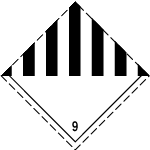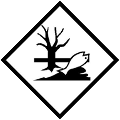SAFETY DATA SHEET
Lowicryl K11M - Monomer I
1. IDENTIFICATION
Product Identifiers
Product Name:
Lowicryl K11M - Monomer I
Other Names:
Lowicryl K11M Kit
Product Number(s):
C450_2
CAS Number:
-
Recommended use of the chemical and restriction on use
Laboratory use.
Company Details
ProSciTech Pty Ltd
11 Carlton Street
KIRWAN QLD 4817
Australia(07) 4773 9444www.proscitech.com
11 Carlton Street
KIRWAN QLD 4817
Australia(07) 4773 9444www.proscitech.com
Emergency Contact Details
ProSciTech Pty Ltd
11 Carlton Street
KIRWAN QLD 4817
Australia(07) 4773 9444www.proscitech.com
11 Carlton Street
KIRWAN QLD 4817
Australia(07) 4773 9444www.proscitech.com
2. HAZARDS IDENTIFICATION
Classification of the substance or mixture
GHS05 corrosion
Skin Corr. 1B H314 Causes severe skin burns and eye damage.
Eye Dam. 1 H318 Causes serious eye damage.
GHS07
Acute Tox. 4 H312 Harmful in contact with skin.
Skin Sens. 1 H317 May cause an allergic skin reaction.
STOT SE 3 H335 May cause respiratory irritation.
Skin Corr. 1B H314 Causes severe skin burns and eye damage.
Eye Dam. 1 H318 Causes serious eye damage.
GHS07
Acute Tox. 4 H312 Harmful in contact with skin.
Skin Sens. 1 H317 May cause an allergic skin reaction.
STOT SE 3 H335 May cause respiratory irritation.
Label Elements


Signal Words
Danger
Hazard Statement(s)
Harmful in contact with skin.
Causes severe skin burns and eye damage.
May cause an allergic skin reaction.
May cause respiratory irritation.
Causes severe skin burns and eye damage.
May cause an allergic skin reaction.
May cause respiratory irritation.
Precautionary Statement(s)
Wear protective gloves.
Wear protective gloves / protective clothing.
Wear eye protection / face protection.
Wash thoroughly after handling.
Use only outdoors or in a well-ventilated area.
Contaminated work clothing should not be allowed out of the workplace.
Wear protective gloves / protective clothing.
Wear eye protection / face protection.
Wash thoroughly after handling.
Use only outdoors or in a well-ventilated area.
Contaminated work clothing should not be allowed out of the workplace.
Primary route(s) of entry
Not available.
Human Health
Inhalation:
Remove person to fresh air and keep comfortable for breathing.
Ingestion:
Rinse mouth. Do NOT induce vomiting. Take off contaminated clothing and wash it before reuse.
Eyes:
Rinse cautiously with water for several minutes. Remove contact lenses, if present and easy to do. Continue rinsing.
Immediately call a POISON CENTER/doctor. Specific treatment (see on this label).
Immediately call a POISON CENTER/doctor. Specific treatment (see on this label).
Skin:
(or hair): Take off immediately all contaminated clothing. Rinse skin with water//shower.
Wash contaminated clothing before reuse. If skin irritation or rash occurs: Get medical advice/attention.
Wash contaminated clothing before reuse. If skin irritation or rash occurs: Get medical advice/attention.
Environment
Dispose of contents/container in accordance with local/regional/national/international regulations.
3. COMPOSITION/INFORMATION ON INGREDIENTS
Name
CAS No.
Content (w/w)
Classification
Methacrylic acid, monoester with propane-1,2-diol
27813-02-1
25-50%
-
2-hydroxyethyl acrylate
818-61-1
25-50%
-
2-ethoxyethyl methacrylate
2370-63-0
10-25%
-
N-BUTYL METHACRYLATE, MONOMER
-
10-25%
-
4. FIRST AID MEASURES
Ingestion
Drink plenty of water and provide fresh air. Call for a doctor immediately.
Inhalation
Supply fresh air and to be sure call for a doctor. In case of unconsciousness place patient stably in side position for transportation.
Skin Contact
Immediately wash with water and soap and rinse thoroughly.
Eye Contact
Rinse opened eye for several minutes under running water. Then consult a doctor.
Other Information
Immediately remove any clothing soiled by the product. Symptoms of poisoning may even occur after several hours; therefore medical observation for at least 48 hours after the accident.
5. FIREFIGHTING MEASURES
Suitable extinguishing equipment
CO₂, powder or water spray. Fight larger fires with water spray or alcohol resistant foam.
HAZCHEM
Not available.
Special protective equipment and precautions for fire fighters
6. ACCIDENTAL RELEASE MEASURES
Personal precautions, protective equipment and emergency procedures
Wear protective equipment. Keep unprotected persons away.
Environmental precautions
Do not allow to enter sewers/ surface or ground water.
Methods and materials for containment and clean up
Absorb with liquid-binding material (sand, diatomite, acid binders, universal binders, sawdust).
Use neutralising agent.
Dispose contaminated material as waste according to item 13. Ensure adequate ventilation.
Use neutralising agent.
Dispose contaminated material as waste according to item 13. Ensure adequate ventilation.
7. HANDLING AND STORAGE
Precautions for safe handling
Ensure good ventilation/exhaustion at the workplace.
Prevent formation of aerosols
Prevent formation of aerosols
Conditions for safe storage
8. EXPOSURE CONTROLS/PERSONAL PROTECTION
Exposure Standards
Engineering controls
No special requirements.
Personal protective equipment
Eye and face protection
Tightly sealed goggles.
Skin protection
Protective gloves
The glove material has to be impermeable and resistant to the product/ the substance/ the preparation.
Due to missing tests no recommendation to the glove material can be given for the product/ the preparation/ the chemical mixture.
Selection of the glove material on consideration of the penetration times, rates of diffusion and the degradation.
Material of gloves.
The selection of the suitable gloves does not only depend on the material, but also on further marks of quality and varies from manufacturer to manufacturer. As the product is a preparation of several substances, the resistance of the glove material can not be calculated in advance and has therefore to be checked prior to the application.
Penetration time of glove material.
The exact break through time has to be found out by the manufacturer of the protective gloves and has to be observed.
The glove material has to be impermeable and resistant to the product/ the substance/ the preparation.
Due to missing tests no recommendation to the glove material can be given for the product/ the preparation/ the chemical mixture.
Selection of the glove material on consideration of the penetration times, rates of diffusion and the degradation.
Material of gloves.
The selection of the suitable gloves does not only depend on the material, but also on further marks of quality and varies from manufacturer to manufacturer. As the product is a preparation of several substances, the resistance of the glove material can not be calculated in advance and has therefore to be checked prior to the application.
Penetration time of glove material.
The exact break through time has to be found out by the manufacturer of the protective gloves and has to be observed.
Body protection
Keep away from foodstuffs, beverages and feed.
Immediately remove all soiled and contaminated clothing
Wash hands before breaks and at the end of work.
Avoid contact with the eyes.
Avoid contact with the eyes and skin.
Immediately remove all soiled and contaminated clothing
Wash hands before breaks and at the end of work.
Avoid contact with the eyes.
Avoid contact with the eyes and skin.
Respiratory protection
In case of brief exposure or low pollution use respiratory filter device. In case of intensive or longer exposure use self-contained respiratory protective device.
9. PHYSICAL AND CHEMICAL PROPERTIES
General information
Appearance
Liquid Colour: According to product specification.
Odour
Characteristic
pH
Not determined.
Vapour Pressure
at 20 °C: 3 hPa
Density
1.029 g/cm³
Boiling Point
246 °C
Melting Point
Undetermined.
Solubility
Not miscible or difficult to mix with water.
Specific Gravity of Density
Not applicable.
Flash Point
> 93 °C
Flammable (Explosive) Limits
Not determined
Ignition Temperature
290 °C
Formula
Not available.
10. STABILITY AND REACTIVITY
Reactivity
No further relevant information available.
Chemical stability
No decomposition if used according to specifications.
Possibility of hazardous reactions
No dangerous reactions known.
Conditions to avoid
No further relevant information available.
Incompatible materials
No further relevant information available.
11. TOXICOLOGICAL INFORMATION
Acute effects
No further relevant information available.
Eye contact
Strong caustic effect.
Strong irritant with the danger of severe eye injury.
Strong irritant with the danger of severe eye injury.
Skin contact
Strong caustic effect on skin and mucous membranes.
Ingestion
No further relevant information available.
Inhalation
Sensitisation possible through skin contact.
Toxicity and irritation
The product shows the following dangers according to the calculation method of the General EU Classification Guidelines for Preparations as issued in the latest version:
Harmful
Corrosive
Irritant
Swallowing will lead to a strong caustic effect on mouth and throat and to the danger of perforation of esophagus and stomach.
Harmful
Corrosive
Irritant
Swallowing will lead to a strong caustic effect on mouth and throat and to the danger of perforation of esophagus and stomach.
12. ECOLOGICAL INFORMATION
Ecotoxicity
No further relevant information available.
Persistence and degradability
No further relevant information available.
Bioaccumulative potential
No further relevant information available.
Other adverse effects
Water hazard class 2 (German Regulation) (Self-assessment): hazardous for water Do not allow product to reach ground water, water course or sewage system.
Must not reach sewage water or drainage ditch undiluted or unneutralised.
Danger to drinking water if even small quantities leak into the ground.
Must not reach sewage water or drainage ditch undiluted or unneutralised.
Danger to drinking water if even small quantities leak into the ground.
13. DISPOSAL CONSIDERATIONS
General information
Must not be disposed together with household garbage. Do not allow product to reach sewage system·
Uncleaned packaging:
Recommendation:Disposal must be made according to official regulations.
Uncleaned packaging:
Recommendation:Disposal must be made according to official regulations.
14. TRANSPORT INFORMATION
ADG label required


HAZCHEM
Not available.
UN Number
UN3082
Proper shipping name
3082 ENVIRONMENTALLY HAZARDOUS SUBSTANCE, LIQUID, N.O.S. (2-hydroxyethyl acrylate).
Transport hazard class
9 M
Packing group
III
Environmental hazard
Product contains environmentally hazardous substances: 2- hydroxyethyl acrylate
Marine pollutant: Yes
Marine pollutant: Yes
Special precautions for users
Warning: Miscellaneous dangerous substances and articles.
Danger code (Kemler): 90
EMS Number: F-A,S-F
Danger code (Kemler): 90
EMS Number: F-A,S-F
Additional information
ADG
Limited quantities (LQ) 5L
Excepted quantities (EQ) Code: E1
Maximum net quantity per inner packaging: 30 m.l
Maximum net quantity per outer packaging: 1000 ml.
Transport category 3
Tunnel restriction code E
Limited quantities (LQ) 5L
Excepted quantities (EQ) Code: E1
Maximum net quantity per inner packaging: 30 m.l
Maximum net quantity per outer packaging: 1000 ml.
Transport category 3
Tunnel restriction code E
15. REGULATORY INFORMATION
Poisons Schedule Number
None of the ingredients is listed.
Other Information
No further relevant information available.
16. OTHER INFORMATION
SDS preparation date
28 November 2024
Comments
This information is based on our present knowledge. However, this shall not constitute a guarantee for any specific product features and shall not establish a legally valid contractual relationship.
This Safety Data Sheet (SDS) has been prepared in compliance with the Preparation of Safety Data Sheets for Hazardous Chemicals Code of Practice February 2016. It is the user's responsibility to determine the suitability of this information for adoption of necessary safety precautions. The information published in this SDS has been compiled from the publications listed in Section 16: to the best of our ability and knowledge these publications are considered accurate. We reserve the right to revise Safety Data Sheets as new information becomes available. Copies may be made for non-profit use.